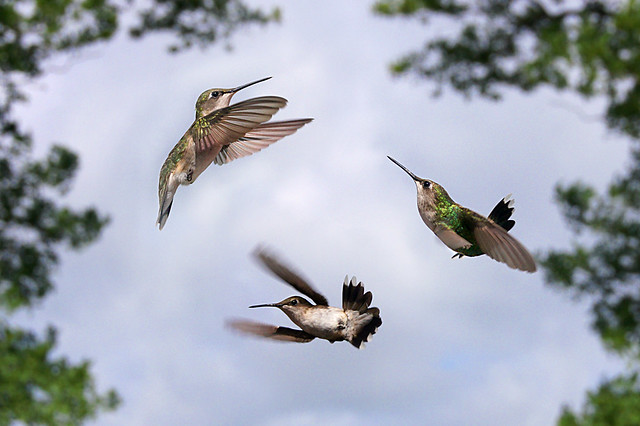

The plumage is molted once a year on the wintering grounds, beginning in early fall and ending by late winter. Juvenile males resemble adult females, though usually with heavier throat markings. Males are smaller than females and have slightly shorter bills. The female has a notched tail with outer feathers banded in green, black, and white and a white throat that may be plain or lightly marked with dusky streaks or stipples. The red iridescence is highly directional and appears dull black from many angles. The adult male has a gorget (throat patch) of iridescent ruby red bordered narrowly with velvety black on the upper margin and a forked black tail with a faint violet sheen. The ruby-throated hummingbird can only shuffle to move along a branch, though it can scratch its head and neck with its feet. The middle toe is around 0.6 cm (0.24 in). The toes are formed as claws (image) with ridged inner surfaces to aid gripping onto flower stems or petals. Hummingbird legs are short with no knees, and have feet with three toes pointing forward and one backward – the hallux. Their bill, at up to 2 cm (0.79 in), is long, straight, and slender.Ĭlose-up of toe arrangement in a ruby-throated hummingbird foot, showing three claw-like toes forward and one backward. Adults are metallic green above and grayish white below, with near-black wings. Weight can range from 2 to 6 g (0.071 to 0.212 oz), with males averaging 3.4 g (0.12 oz) against the slightly larger female which averages 3.8 g (0.13 oz). This hummingbird is from 7 to 9 cm (2.8 to 3.5 in) long and has an 8 to 11 cm (3.1 to 4.3 in) wingspan. The species is monotypic: no subspecies are recognised. The ruby-throated hummingbird is now placed in the genus Archilochus that was introduced in 1854 by the German naturalist Ludwig Reichenbach. The specific epithet colubris is from the Spanish colibrí meaning "hummingbird". Linnaeus based his description on the earlier account by Mark Catesby in his The Natural History of Carolina, Florida and the Bahama Islands that had been published in 1729 and that by George Edwards in his A Natural History of Uncommon Birds that had been published in 1743. The ruby-throated hummingbird was formally described by the Swedish naturalist Carl Linnaeus in 1758 in the tenth edition of his Systema Naturae under the binomial name Trochilus colubris.

It is the most common hummingbird in eastern North America, having population estimates of about 35 million in 2021. The ruby-throated hummingbird ( Archilochus colubris) is a species of hummingbird that generally spends the winter in Central America, Mexico, and Florida, and migrates to Canada and other parts of Eastern North America for the summer to breed.


 0 kommentar(er)
0 kommentar(er)
